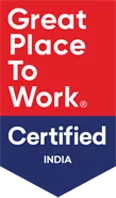Success Story
Developing a custom hospital information system (HIS) for Maharaja Agrasen Medical College
Services Used:
Maharaja Agrasen Medical Education & Scientific Research Society was founded in 1998 with the aim to provide healthcare services and medical education. The hospital operates with 5,00,000 annual OPDs and has a hospital strength that includes MBBS & PG students, nurses, faculty, and non-teaching staff. It serves around 3,000 patients in OPD, every day. An average of 50 (major) and 90 (minor) surgeries are performed in a day with all administrative, financial, and clinical data recorded manually on papers.
- 25% savings as compared to previous infrastructure
- 50% reduction in manual administration time
- 35% increase in efficiency
Business Situation
The lack of a digital interface for data entry and data visualization posed several challenges at the hospital and departmental levels. For example, there were no records for how assets are used from the hospital inventory. There was no system in place for accounts management (attendance automation, salary, calculation, arrears management, etc.). The blood bank, pharmacy, and laboratory processes lacked automation with data being completely decentralized. Such situations resulted in a lack of transparency, overestimation of assets, no visibility of how a work cycle operates at the departmental level, etc. Hence, a customized hospital management system was critical to manage day-to-day activities of the hospital.
Therefore, MAMC was on the look around for an experienced technology partner who could help them to digitally transform the healthcare delivery system. MAMC choose Daffodil Software for its extensive experience in building custom healthcare IT solutions, electronic health records (EHR) software, telehealth solutions, digital pharmacy, HIS & practice management systems, etc.
MAMC had the following key expectations from the Healthcare Information System:
- The patient footfall at MAMC is extensive and thus the new digital system should act as a support to the present process without compromising with the overall efficiency.
- Process automation, data entry, and data visualization with the system should be simple, ensuring easy adoption by the internal members.
- The hospital attends to rural population as patients. Thus, the new system should not become a hurdle for them.
- The new system should deal with overall data and process flow involving the entire hospital and respective departments.
The Solution
Team Daffodil developed a comprehensive Hospital Information System (HIS) that would help to automate processes, centralize data, and improve information access.
- A web-based application was developed with key modules to manage the hospital system
- A mobile app with OPD and IPD module features was developed for patient management
- A web-based admin app was developed to manage roles, users, departments, suppliers, etc.
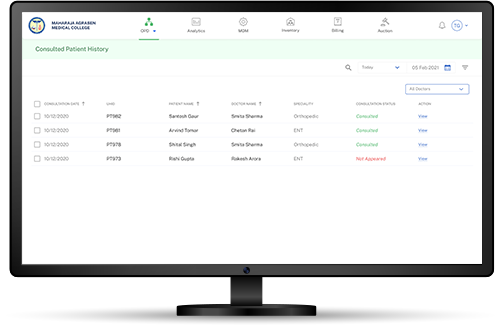
To build this complex, interactive solution where minute details needed to be emphasized, team Daffodil followed a phase-wise approach. This development approach was expected to offer the following benefits:
- It helps in the gradual adoption of the new system.
- It helps to prioritize modules and functionality that will address the burning challenges and provide a quick turnaround time.
- It helps to get feedback from actual users in less time.
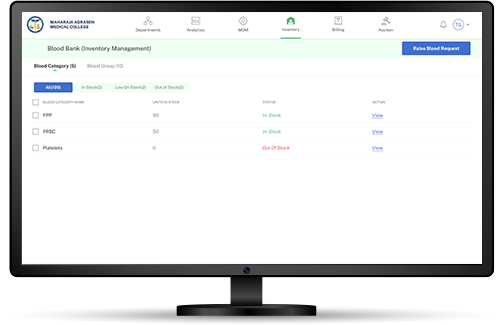
Requirement Analysis and Documentation
To understand the pain points of the hospital’s care team, Daffodil conducted F2F discussions at the department level. A team of business analysts interviewed the care team to understand how the system works for each department, what are their challenges, and what do they expect from a new, improved system. Moreover, team Daffodil interacted with the patients to understand how certain processes (such as consultation, lab tests, report collection, etc.) can be eased for them.
The requirement gathering was followed by documentation of how the existing challenges can be resolved. This included creating flow charts for working of every department, a comparative analysis on how the system flow can be simplified, creating designs (UI/UX), and architecture for the solution.
These designs were showcased to the MAMC team for approval. Upon approval from the stakeholders (at DMS & department level), a prototype (wireframes) was generated and again shared for approval.
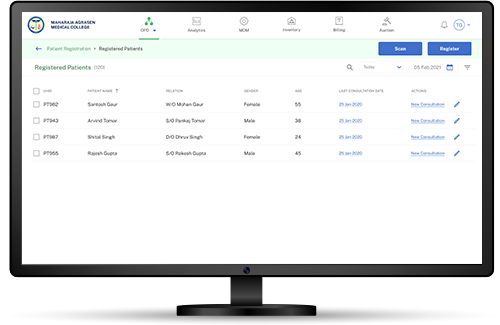
Development and Implementation
Team Daffodil adopted a modular approach to the development of a complex Hospital Information System. The application was divided into modules and sub-modules so that development and testing could be eased.

The HIS for Maharaja Agrasen Medical College had the following key modules:
- OPD: This involves patient registration, billing, medicine allocation, and patient identification through bar code, labs/investigation data centralization.
- IPD: Patient admission, bed allotment, department wise data for bed occupancy, patient recovery tracking, billing, discharge, and release.
- Pharmacy Inventory: Allocation of medicine and centralized data, QR code scanning for proper identification of the patient, medicine inventory management, notification on expiry of medicine.
- Pharmacy Store: Prescription upload, medicine allotment, bills generation.
- Assets Store: Centralized data, department wise data maintenance, online asset request by the department, and request fulfilment.
- Lab: Process automation and data centralization, facilitating duplicate report generation, barcode scanning to identify patients.
- Vaccination: Process automation and data centralization.
- Blood Bank: Donor registration, records maintenance, patient details.
- Accounts: Salary calculation, attendance automation, access of salary slip to teaching and non-teaching staff, arrears management, and gradual automation of the entire salary process.
- File and Bill Management: Online file initiation, online approval, online forwarding of files/bills to different departments.
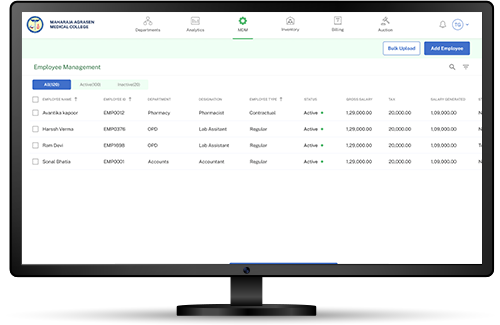
Admin Panel
Users with access to admin rights will be responsible for managing roles, rights, and data visibility. The admin panel has the facility to manage the following segments of the hospital system:
- Users and roles management
- Department management
- Lab management
- Medicine management
- Asset master management
- Leave policy management
- OT master management
- Supplier management, etc.
For the MAMC team to get started with the application, department-wise onsite training was provided by team Daffodil. Moreover, fixes and issue resolution would be provided for any functional and technical deformity in the application (as a part of annual maintenance).
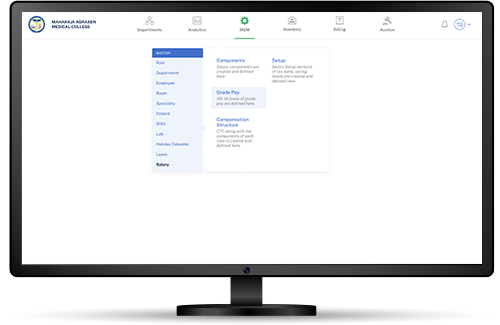
The Impact
Team Daffodil developed a comprehensive Hospital Information System (HIS) that would help to automate processes, centralize data, and improve information access with the latest UI/UX enabling users and hospital admin staff to make the most of the system. The client has been extremely satisfied by the way Daffodil has executed the entire project. The client was able to launch the solution in a timely and desired manner as Daffodil ensured that the deliverables were provided on time while maintaining the utmost quality. Daffodil came up with a precise, modernized version of the solution best suited to the clients requirements.
Read Related Case Studies
Get in Touch
Sign up for a 30 min no-obligation strategic session with us
Let us understand your business objectives, set up initial milestones, and plan your software project.
At the end of this 30 min session, walk out with:
- Validation of your project idea/ scope of your project
- Actionable insights on which technology would suit your requirements
- Industry specific best practices that can be applied to your project
- Implementation and engagement plan of action
- Ballpark estimate and time-frame for development






